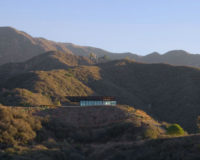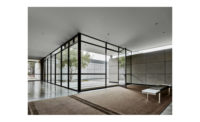Montecito, California
'Now, the early guys got it. Schindler, Neutra, Wright,' says Barton Myers, sitting on a ledge of the terrace outside of his most recent steel and glass house in Montecito, California, completed in 2009. What those guys, the ones Myers reveres, got was the dialogue between the inside and the outdoors. A West Coast house should embrace the garden, not shutter it out. This isn't Canada, where Myers practiced early on in his career. Myers's Modernism here ' Barton Myers Associates is based in Los Angeles ' is a distinctly regional one, rooted in the mild, bug-less climate of Southern California. It embraces Spanish and Moorish influences that migrated north from Mexico, and the Eastern idea of the garden as paradise.
The Montecito Residence sits on a 1-acre site in the hills of Santa Barbara. A steep ravine cuts off the property to the east, ending in a creek. Thomas Schneider, associate in charge, recalls the tons of sandstone boulders that were hauled from the site where a small derelict house once stood, and the perseverance required to see the adventurous project to completion. Other boulders were saved, melding the house with its coarse site, but the south-facing 3,360-square-foot main residence doesn't attempt to mimic the land. It's distinctly man-made, a transparent living machine, with three 20-foot-wide sectional glass and steel overhead doors. When fully open, as they were on an early February day, the doors rest under the metal deck roof. 'These doors are so ingenious,' says Myers. 'You lift thousands of pounds, and they're beautifully torqued with all the gear chains.' Myers insists that it's the doors, which he used in all four California houses, and not the glass, that remove the barriers. 'You're fooled that a glass building is totally a transparent building,' he said. 'It has reflections, it has all sorts of problems. Even if you're inside a glass room, it's not the same as being without that door.'
The main residence is broken into two parallel wings connected by a small hallway that contains a pantry and bathroom. The living room and kitchen face a terrace, which is shaded by the metal deck roof's 10-foot cantilever. Steel I-beams and a 6-foot-high clerestory window that spans the length of the living room and kitchen frame views of the Santa Ynez Mountains. 'To me, the I-section is such a beautiful column because it's so precise and you get the shade and shadow in them. If you use the right paint, you see the beauty of the steel,' says Myers of his adaptation of Mies's corner details. In some corners the columns are pushed aside to make way for glass pocket doors. The Gardners chose a complementary industrial Bulthaup kitchen and asked Myers to create a reading room with a fireplace off the kitchen for a cozier, denlike space.
The house has no air-conditioning system, and poured-in-place concrete floors feature radiant heating. With photovoltaics on the garage and solar thermal collectors over the library, the Gardners say their electric bill registers in the single digits. 'The house has a lot of glass, and that is usually controversial when you talk about sustainability,' says Schneider, but in the end it complies with California's energy code, Title 24 ' the most stringent in the country. 'The client is able to slide windows and doors open and closed as the day progresses to create a comfortable climate in each space.'
Myers compares the parti of the house, with the separate bar building for bedrooms and library, to Marcel Breuer's 1940s concept of bi-nuclear houses. 'It makes a lot of sense. The acoustical privacy, the sense of moving from a broad public space to a more private space,' he says. Bedrooms and bathrooms are located off a grand hallway. Outside, Japanese-influenced courtyards with landscaping by Rios Clementi Hale Studios break up the two sections of the main residence. The firm also added decorative warmth to the interiors to contrast with the industrial finishes. (The Gardners didn't touch a modern adobe-style guesthouse on the property. It had been recently renovated by Neumann Mendro Andrulaitis Architects.)
One gets a peek at the Pacific from the edge of the lap pool in the front of the house. A fountain pours into it but doesn't quite drown out the sound of the occasional car, probably a convertible, whooshing down the road ' the California soundtrack.
Lot Size: 1 acre
Size: 3,360 sq.ft. main residence, 500 sq.ft. garage, 50’ lap pool & pergola, plus 715 sq.ft. existing guest house
Completion Date: 2009
Architect'
Barton Myers Associates, Inc.
People
Architect Associate-in-charge: Barton Myers, Thomas Schneider Project Architect: Yianna Bouyioukou Wayne Thomas, Cheng Zhou, David Karp
Landscape Architects / Interiors
Engineering Mechanical & Plumbing: AGME Engineers
Electrical: Smith Engineering Associates
Contractor
Photographer |
Products
Structural system
Exterior cladding
Roofing
Interior Finishes Fireplaces: Custom masonry (wood burning); Majestic (gas)
Windows/Doors Sliding doors: Fleetwood Overhead Doors: Arm-R-Lite
Hardware
Lighting
Audio/Video:
Furnishings Kitchen Cabinets: Bulthaup Kitchen Appliances: Sub-Zero, Miele, Daccor, Gaggenau, Whirlpool, U-line Bathrooms Cabinets: Custom millwork
Plumbing Faucets: Vola, Speakman, Dornbracht, PE Guerrin, Waterworks Toilets: Toto Accessories: Boffi, Cool Line |










Post a comment to this article
Report Abusive Comment